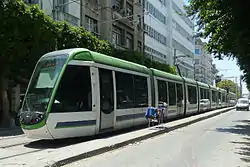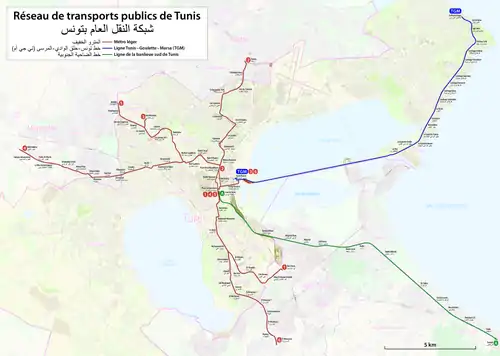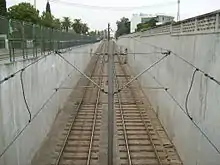Tunis Light Metro
The Tunis Metro (Tunis light metro, also Tunis light rail, Tunisian Arabic: المترو الخفيف لمدينة تونس, el-metrū el-khfīf li-mdīnat tūnis) is an expanding public transportation network for the Tunis metropolitan area that was started in 1985. It represents not a typical subterranean heavy rail service, but a light rail system.
| Tunis Light Metro المترو الخفيف لمدينة تونس | |||
|---|---|---|---|
 .jpg.webp) From top: Alstom Citadis of Lines 5-6; TW 6000 of Lines 1-4 | |||
| Overview | |||
| Locale | Tunis, Tunisia | ||
| Transit type | Light rail | ||
| Number of lines | 6 | ||
| Number of stations | 80 (2021) | ||
| Operation | |||
| Began operation | 1985 | ||
| Operator(s) | Société des transports de Tunis | ||
| Number of vehicles | 173 (134 Siemens and 39 Alstom Citadis) | ||
| Technical | |||
| System length | 45.2 km (28.1 mi) | ||
| Track gauge | 1,435 mm (4 ft 8+1⁄2 in) standard gauge | ||
| Electrification | Overhead lines, 750 V DC | ||
| |||
Metro leger's light rail system has its track at surface level generally with its own rail bed, but at key intersections, the system goes underground to avoid congestion or has the right of way. Together with the TGM commuter rail line, it is managed by the parastatal transport authority Société des transports de Tunis (Transtu).
While a number of African cities once had traditional electric tram systems, all but the Alexandria Tram were discontinued. The Metro leger's modern light rail system was originally unique for Africa, but there are now modern trams in Algeria and Morocco, as well.
History
.jpg.webp)
Tunis had an older electric tram system that, like in many cities, eventually was dismantled. With the postwar growth of the metropolitan area and the traffic congestion that followed, the need for a commuter transportation system became evident. The city eventually reached the decision to link the suburbs to the city center with a modern network of light rail. Preliminary studies were undertaken in 1974.[1] The system was delivered as a turnkey operation by a consortium led by Siemens.[2] The Société du métro léger de Tunis (SMLT) was founded in 1981 to manage the operation.
Public transport is overseen by Tunisia’s Ministry of Transport, with constituent bodies operating the various modes. The Société Nationale des Chemins de Fer Tunisiens (SNCFT) has continued development of the heavy rail standard and metre gauge routes, initiated under French control, with the 1,435mm operation centred on Tunis. Tunis is just inland and set on low-lying land around several lakes. The heart of the city, the Medina, has a street pattern that long predates the industrial era or motorised transport. In 2003, the city’s own road and rail public transport modes came together under the jurisdiction of the Société des Transports de Tunis, operating under the Transtu name.
Accounting for almost three quarters of revenue (2006), the company operates 217 bus routes over 6,882 km with a fleet of 1,114 vehicles. As with most other large cities, road congestion is a feature of Tunis, although the challenge for public transport is as much about increasing capacity on their already well-used services as it is about stemming the rise in car use.[3]
Construction on Line 1 started the same year, and passenger services commenced in 1985.[4] In 1989, Line 2 was placed into operation, with Line 3 and 4 following the next year. Line 5 became operative in 1992, while in the same year Line 3 was extended to its current length. In 1997, the extension of Line 4 was inaugurated, and further construction for an extension to La Manouba was started in 2007. The Société des transports de Tunis took over management in 2003; it was formed by joining the SMLT and the Société nationale de transports (SNT, founded in 1963) that was responsible for the TGM railway. A new Line 6 was planned to link Tunis with El Mourouj and its construction began in 2005. The completion of this new line finished in 2009. New Alstom Citadis trains to supplement the earlier Siemens trains were introduced in 2007.[5]
Network
| Tunis Metro | |||||
|---|---|---|---|---|---|
| Line | Length | Stations | Opened | Equipment | |
| Place de Barcelone – Ben Arous | 5.5 km | 11 | 1985 | Siemens | |
| Place de la République – Ariana | 6.3 km | 12 | 1989 | Siemens | |
| Tunis Marine – Ibn Khaldoun | 6.5 km | 13 | 1990 | Siemens | |
| Place de Barcelone – Kheireddine | 10 km | 20 | 1990 | Siemens | |
| Place de Barcelone – Intilaka | 7.1 km | 14 | 1992 | Alstom Citadis | |
| Tunis Marine – El Mourouj 4 | 6.8 km | 18 | 2008 | Alstom Citadis | |

Line 1
Line 1 | ||||||||||||||||||||||||||||||||||||||||||||||||||||||||||||||||||||||||||||||||||||
|---|---|---|---|---|---|---|---|---|---|---|---|---|---|---|---|---|---|---|---|---|---|---|---|---|---|---|---|---|---|---|---|---|---|---|---|---|---|---|---|---|---|---|---|---|---|---|---|---|---|---|---|---|---|---|---|---|---|---|---|---|---|---|---|---|---|---|---|---|---|---|---|---|---|---|---|---|---|---|---|---|---|---|---|---|
| ||||||||||||||||||||||||||||||||||||||||||||||||||||||||||||||||||||||||||||||||||||
- Place de Barcelone – Ben Arous
- Opened: 1985
- Number of stations: 11
Line 1 is the oldest line and it is the shortest line compared to the 5 other lines. It has 11 stations.
The start of work on line 1, which began in 1981, was completed with the commissioning of the line (towards Ben Arous) in 1985.
The connection between bus lines and line 1 at the station of El Ouardia intervenes a year later, in 1986.
Line 2
Line 2 | |||||||||||||||||||||||||||||||||||||||||||||||||||||||||||||||||||||||||||||||||||||||||||
|---|---|---|---|---|---|---|---|---|---|---|---|---|---|---|---|---|---|---|---|---|---|---|---|---|---|---|---|---|---|---|---|---|---|---|---|---|---|---|---|---|---|---|---|---|---|---|---|---|---|---|---|---|---|---|---|---|---|---|---|---|---|---|---|---|---|---|---|---|---|---|---|---|---|---|---|---|---|---|---|---|---|---|---|---|---|---|---|---|---|---|---|
| |||||||||||||||||||||||||||||||||||||||||||||||||||||||||||||||||||||||||||||||||||||||||||
- Place de la République – Ariana
- Opened: 1989
- Number of stations: 12
Line 2 is the oldest line and it is the shortest line after the Line 1. It has 12 stations. Construction on Line 2 started the same year, and passenger services commenced in 1989.
Line 3
Line 3 | ||||||||||||||||||||||||||||||||||||||||||||||||||||||||||||||||||||||||||||||||||||||||||||||||||
|---|---|---|---|---|---|---|---|---|---|---|---|---|---|---|---|---|---|---|---|---|---|---|---|---|---|---|---|---|---|---|---|---|---|---|---|---|---|---|---|---|---|---|---|---|---|---|---|---|---|---|---|---|---|---|---|---|---|---|---|---|---|---|---|---|---|---|---|---|---|---|---|---|---|---|---|---|---|---|---|---|---|---|---|---|---|---|---|---|---|---|---|---|---|---|---|---|---|---|
| ||||||||||||||||||||||||||||||||||||||||||||||||||||||||||||||||||||||||||||||||||||||||||||||||||
- Tunis Marine – Ibn Khaldoun
- Opened: 1990
- Number of stations: 14
Line 3 is composed of 14 stations and passenger services commenced in 1990. In 2017, the Tunis Transport Company announced the removal of the Habib-Thameur station following a fire which destroyed the ticket sales point.[6]
The station of Tunis Marine has also a line of TGM . It's the only station that represents a Metro station and a TGM station both.
Line 4
Line 4 | |||||||||||||||||||||||||||||||||||||||||||||||||||||||||||||||||||||||||||||||||||||||||||||||||||||||||||||||||||||||||||||||||||||||||||||||||||
|---|---|---|---|---|---|---|---|---|---|---|---|---|---|---|---|---|---|---|---|---|---|---|---|---|---|---|---|---|---|---|---|---|---|---|---|---|---|---|---|---|---|---|---|---|---|---|---|---|---|---|---|---|---|---|---|---|---|---|---|---|---|---|---|---|---|---|---|---|---|---|---|---|---|---|---|---|---|---|---|---|---|---|---|---|---|---|---|---|---|---|---|---|---|---|---|---|---|---|---|---|---|---|---|---|---|---|---|---|---|---|---|---|---|---|---|---|---|---|---|---|---|---|---|---|---|---|---|---|---|---|---|---|---|---|---|---|---|---|---|---|---|---|---|---|---|---|---|
| |||||||||||||||||||||||||||||||||||||||||||||||||||||||||||||||||||||||||||||||||||||||||||||||||||||||||||||||||||||||||||||||||||||||||||||||||||
- Place de Barcelone – Kheireddine
- Opened: 1990
- Number of stations: 20
Line 4 is the largest station compared to the other 5 stations. It is composed of 20 stations and passenger services commenced in 1990. in 1992, other stations were put online
Line 5
Line 5 | |||||||||||||||||||||||||||||||||||||||||||||||||||||||||||||||||||||||||||||||||||||||||||||||||||||||||
|---|---|---|---|---|---|---|---|---|---|---|---|---|---|---|---|---|---|---|---|---|---|---|---|---|---|---|---|---|---|---|---|---|---|---|---|---|---|---|---|---|---|---|---|---|---|---|---|---|---|---|---|---|---|---|---|---|---|---|---|---|---|---|---|---|---|---|---|---|---|---|---|---|---|---|---|---|---|---|---|---|---|---|---|---|---|---|---|---|---|---|---|---|---|---|---|---|---|---|---|---|---|---|---|---|---|
| |||||||||||||||||||||||||||||||||||||||||||||||||||||||||||||||||||||||||||||||||||||||||||||||||||||||||
- Place de Barcelone – Intilaka
- Opened: 1992
- Number of stations: 14
Line 5 is composed of 14 stations since 2017 after a fire which burned the gutters of the Habib-Thameur station.
The line has many important place like the University of El Manar (Campus) also Bab Saadoun where is the rental cars (louages)
Line 6
Line 6 | |||||||||||||||||||||||||||||||||||||||||||||||||||||||||||||||||||||||||||||||||||||||||||||||||||||||||||||||||||||||||||||||||||||
|---|---|---|---|---|---|---|---|---|---|---|---|---|---|---|---|---|---|---|---|---|---|---|---|---|---|---|---|---|---|---|---|---|---|---|---|---|---|---|---|---|---|---|---|---|---|---|---|---|---|---|---|---|---|---|---|---|---|---|---|---|---|---|---|---|---|---|---|---|---|---|---|---|---|---|---|---|---|---|---|---|---|---|---|---|---|---|---|---|---|---|---|---|---|---|---|---|---|---|---|---|---|---|---|---|---|---|---|---|---|---|---|---|---|---|---|---|---|---|---|---|---|---|---|---|---|---|---|---|---|---|---|---|---|
| |||||||||||||||||||||||||||||||||||||||||||||||||||||||||||||||||||||||||||||||||||||||||||||||||||||||||||||||||||||||||||||||||||||
- Place de Barcelone – Intilaka
- Opened: 2008
- Number of stations: 18
Line 6 is composed of 18 stations and is the longest line after the line 4. On November 12, 2008, the new line 6 - 6.8 kilometers long and serving eleven stations between Place de Barcelona and El Mourouj 4 - came into service after work started in 2005 and commissioning on August 11, 2008 by a first section to El Mourouj 2 ans 3.
Like the line 3, line 6 has a TGM line in Tunis Marine station.
Infrastructure

With the city set for continuing population growth, preliminary studies for light rail, the Métro Léger, began in 1974. A Siemens-led consortium won the contract to create the 1,435mm, overhead supply surface network. Line 1, Tunis Marine (also city terminus for the TGM) to Ben Arous in the south, opened in 1985.[7]
Tram vehicles
By 2006, 136 articulated passenger trams were in operation. They were built by Siemens, and delivered between 1984 and 1997. These trains were derived from the TW 6000 originally developed for Hanover Stadtbahn. The bi-directional trains are powered via a 750 V dc overhead wire and run on a 1,435 mm (4 ft 8+1⁄2 in) track. The trams have a green livery with white and blue lines. A train consists of two wagons each of which has:
- bogies typ Bo-2-2-Bo
- electric motors 2 x 240 kW
- weight of 40.3 tonnes
- length of 30 meters
- width of 2.47 meters
- access from low and high platforms
In 2004, an agreement between the French and Tunisian governments led to the order of 30 new Alstom Citadis trams. Each train consists of two trams of 64 metre length to hold 208 people standing and 58 sitting. The first such trains started to operate on September 17, 2007.[8] 16 more trams were ordered from Alstom in July 2010.[9]
See also
References
- "Tunis Light Rail Development".
- Urbanrail.net information page
- : Tunis Light Rail
- "Tunis Light Rail Development".
- "Transtu".
- "TRANSTU: removal of the Habib Thameur metro station". Retrieved 8 May 2021.
- : Infrastructure
- Hella Lahbib (2007-09-18). "Un tramway nommé plaisir" (in French). La Presse de Tunisie.
- "Tunis orders more trams". Railway Gazette International. 22 July 2010. Retrieved 2010-07-23.
External links
| Wikimedia Commons has media related to Tunis Metro. |